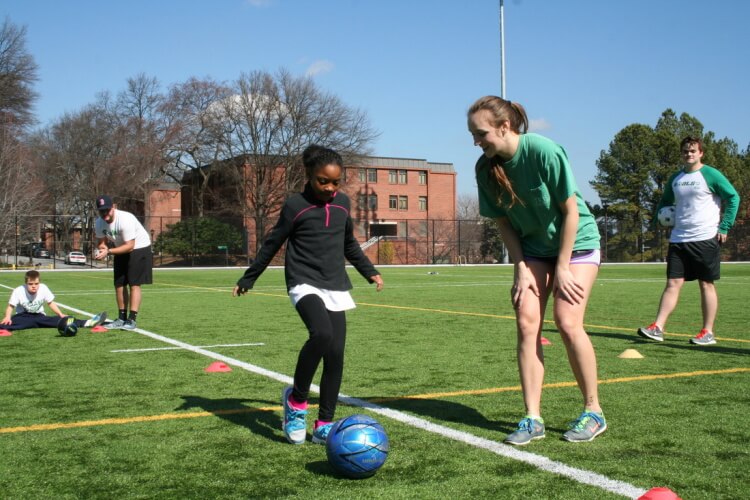Years ago, business visionary Peter Drucker challenged companies to imagine what they’d look like if they hadn’t inherited their present structure. In other words, what would they do differently? What would success look like? It was a novel way to think about change and to resist complacency. A way for companies to anticipate how to stay relevant in a fast-changing world.

Similarly challenged, I’m confident that most physical educators would imagine success as a world in which all of their students choose to be physically active and healthy. It’s something clearly not a reality today but indisputably desirable. The tough part has been translating this vision into practice. Having a clear destination is one thing, but like summiting a mountain, choosing the best route to the top is harder to agree upon. And within the physical education profession, despite consensus about what we’d like to achieve, agreeing on how to get there continues to elude us. This isn’t new. Looking back, it pretty much characterizes our history since the birth of our professional association, the Association for the Advancement of Physical Education (AAPE) 130 years ago.
Unresolved divisions and differences of opinion over professional practice have for more than a century handicapped efforts to move the physical education profession forward. Contentious debate has prevented us from realizing our potential and getting the respect we’ve worked hard to deserve. The lack of agreement on content and outcomes has muddled our mission, confused our thinking, and bewildered the outside world as to what “good” PE looks like. While we may argue otherwise, to the public there’s no difference between physical activity, physical education and athletics, and PE teachers and coaches.
For years, we’ve sought to get our subject respected. We’ve fought for daily PE. Tried to require PE certification. Demanded smaller class sizes. Resisted waivers and substitutions. Defined what quality PE is and is not. And more. But what’s been the result? Some successes certainly, but overall, especially in this era of increased accountability, school PE and its teachers have become increasingly marginalized. We’ve witnessed program reductions and position cuts, ironically as national leaders lament the poor state of children’s health and the urgency to do something about it. You and I know it makes no sense but the bottom line is that the way we’ve tried to promote physical education has not worked. An old American Indian proverb suggests: “If the horse you are riding drops dead, it’s a good time to dismount.” It’s good advice and time we listened.

It’s pretty obvious that the problem we face is messaging. Repeating the same things louder or slower isn’t going to help. It’s not that people outside the profession don’t hear us, but rather that they aren’t listening. They simply aren’t interested in what we’ve been trying to sell them. Like encyclopedia booksellers at a tech show we’re out of place. Our requests for professional support are viewed as self-serving: We’ve become preoccupied with trying to do what’s best for us, making life easier for us to teach, and attempting to legislate our way to job security. That’s not the message the public wants to hear. They couldn’t care less about our jobs or our profession. What they want are healthy kids. But presently they don’t see physical education as the solution.
In February, I spent 5-days listening to proposals by mostly self-declared children’s physical activity experts on ways to successfully tackle the supposed obesity crisis. Now you and I know that it’s really a lack-of-physical-activity crisis and obesity is but a symptom. But I’ll leave that discussion for another time. What disturbed me though at these physical activity promoting events is that health and physical education teachers did not get much of a mention let alone championed for their work. It was as if we were invisible. Not even blips on their radar. Being ignored is one thing, but it gets worse. There is a storm coming that we risk ignoring at our peril.
The volume and variety of physical activity products, programs, and services targeted toward America’s public schools are rapidly expanding. Corporations, foundations, non-profits, government agencies, companies and start-up entrepreneurs are vying to make physical and health education obsolete. They won’t tell you that, but they are clearly determined to slice and dice the school day up, grow their programs, and profit at our expense. If this sounds threatening it should. We are in the midst of a change movement that within a few years could easily displace health and physical education from America’s public schools. The question is, “Are we willing to risk letting others decide our professional fate or instead do what it’s going to take to rescue and preserve our profession?” It’s that simple. We are at a time-sensitive crossroads. We can let others transform the school physical activity environment or take ownership ourselves.
Consider that in America’s 100,000 schools there are an estimated 200,000 certified and well-trained physical and health educators who regularly touch the lives of the nation’s 50 million students continuously during most of the habit-forming years of their lives. An army of influence that has no equal but desperately in need of awakening. For far too long we’ve remained satisfied doing what we’ve always done. We’ve become complacent: Content to teach our classes, maybe do some coaching on the side, but little more. We’ve not worried enough about our impact and now it’s catching up on us. Three decades of tripling obesity hasn’t spurred us to change. It may be unfair to cast us as scapegoats for what is certainly a complex problem but why should an increasingly skeptical audience believe that school health and physical educators are the solution? Where’s the evidence? And in honesty we aren’t the solution. At least not if we persist in doing the same things we’ve been doing and hoping for different results.
So what’s the solution? The first step is simple. The PE and health professions need to step up and take ownerships for changing the physical activity and health attitudes and behaviors of all students in America’s public schools. Not just some but all of them. But to do this we must reimagine the role we play in the lives of our students. In school settings, no one is better positioned nor as well qualified as HPE teachers for designing and sustaining active living and learning environments. How can we do this? Again, it’s not difficult. We all know what must happen. Physical activity has to be integrated into the school (and student’s) day. From the time students arrive to the time they depart, whether getting to and from school, on playgrounds, during recess, in classes, in PE, or after school, students need to be more physically active. They need to be encouraged to practice what they’re learning in their PE classes and they need someone to take an interest in what they are choosing to do in their free time. Every American child needs a personal lifestyle or wellness “coach” and who better to do this than health and physical education teachers.

Of course it’s here that things get more difficult. It’s not as if HPE teachers spend most of their days sitting around looking for new responsibilities to fill in their free time. They are already busy with full teaching schedules. I get that. But it’s a challenge that needs resolving. And solve it we must or our profession will stagnate. History will remember us as “gym” teachers named after the location where we made our last stand. Change is never easy and it won’t be for us. But between change and extinction which will we choose? Without a doubt it’s going to take a huge commitment by every one of us. It’s not something SHAPE America can do for us. Every single one of us, SHAPE America, state and district association leaders, PETE professors, researchers, and most importantly K-12 teachers, everyone has a role to play to support a change movement that will propel our profession to heights unimagined. Health and physical educators recognized as the champions of children’s health and physical activity. No longer the butt of jokes but professionals respected for preparing America’s youth for healthy, happy, and productive adult lives. We must commit to doing this. And now. Trying is not going to be enough.

